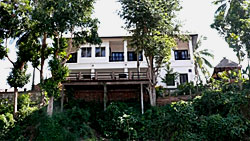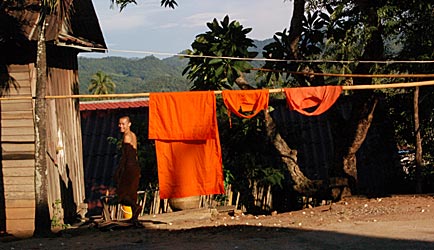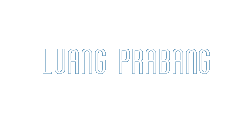









Luang Prabang is a beautiful woman from the provinces caressed by the waters of the Mekong and its tributary, the Nam Khan. To protect its beauty the city was included on the UNESCO World Heritage List in 1995 .
In the dry season from November to May the sand banks adorn it with a crown of pearls. Its elegance seduces tourists. The local population has always venerated the mythical river, christened “Mother of the waters”, which makes a 1865km journey through the country. The Mekong is vital for this landlocked country. It benefits from the melting snows in Tibet, where it has its source at 6000m altitude, and from the first rains of the season to regain its vigour and the ochre tint which so characterises it.
For information, many authors have written works on the city of Luang Prabang, revealing to the public its charm and secrets. Below are some extracts from two books which we recommend you read before and after your visit to Mekong Estate.
“In today’s world carried along by the whirlwind of change Luang Prabang has been able to keep the charm and authenticity of its prestigious past. Coveted by its overpopulated and powerful neighbours China, Vietnam and Thailand, it remains a city of legend where time seems to stand still, a beauty asleep in the shadow of its pagodas where daily life passes in prayer” Francoise Capelle “Luang Prabang, the city of the golden Buddha and the flamboyant” Thalia Editions, Paris 2006.
“Laos, which is landlocked, bounded along its western side by the Mekong, a natural frontier with Thailand, and mountainous to the north and east, has a population of only six millions inhabitants for a surface area equivalent to that of Great Britain. It is the least densely populated country in this part of Asia and therefore a sort of regional exception (…)
The golden age of Laos evoked in patriotic literature was between the 14th and 18th centuries, when the kingdom of Lan Xan (“a million elephants”) occupied double the current area and stood on a level footing with the neighbouring kingdoms (…)
Despite its poverty, which affects its ethnic minorities in particular but not exclusively, Laos is a country of diversity, grace and dignity. The Lao people, facing up to their difficulties, have developed a way of life, a daily joy, ceremonies, traditions, a spirituality which hold in thrall those able to understand them. Laos, which was once, for settlers, indolent or nonchalant is now, for financiers, unfit for the world; peaceful, at one with nature, turned in on itself, it is perhaps one of the last, fragile refuges for poets or wise men fleeing globalisation. Is Laos the last island even though surrounded by land?” Francis Engelmann and Yves Goudineau, “Laos on the banks of the Mekong: from Luang Prabang to the northern provinces” photographs by Serge Sibert, Editions du Chene, Paris 2005.

